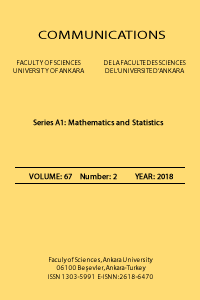ESTIMATION OF EARTHQUAKE INSURANCE PREMIUM RATES: TURKISH CATASTROPHE INSURANCE POOL CASE
Earthquakes are the natural catastrophes which have the high estunpredictability; destructive earthquakes appear less frequently in time andspace. However, the financial impact of such earthquakes on human lives andeconomies is disastrous. The prediction on the occurrence of an earthquakein time, magnitude and location is expressed in terms of their joint probabilities. The estimation on the economic losses mainly depend on the propertiesof the structure. The variability in these variables makes it di¢ cult to collect enough historical information for a precise loss estimation and, hence, fordetermining a realistic insurance premium. This paper questions how muchload should be added to the earthquake insurance premiums which incorporatethe in*uence of the factors being ignored due to the loss of the information.Bayesian regression emphasizing the information needed in optimal premiumvaluation conditional to the parameter estimates, is employed. The implementation of the proposed method is done for the parameter estimation inTurkish Catastrophe Insurance Pool premiums which aims to yield a limited earthquake coverage in a compulsory insurance scheme
Keywords:
Earthquake insurance premium, Bayesian regression Gibbs-sampler, TCIP,
___
- AFAD, Republic of Turkey, Prime Ministry Disaster & Emergency Management Presidency Website www.afad.gov.tr [accessed 20 March 2015]
- Askan, A. and Yucemen, M. S. 2010. Probabilistic methods for the estimation of potential sesimic damage: Application to reinforced concrete buildings in Turkey. Structural Safety 32: 262-271.
- Bommer, J., Spence, R., Erdik, M., Tabuchi, S., Aydinoglu, N., Booth, E., Del Re, D. and Peterken, O. 2002. Development of an earthquake loss model for Turkish Catastrophe Insurance. Journal of Seismology 6: 431-446.
- Crowley, H. and Bommer, J.J. 2006. Modelling seismic hazard in earthquake loss models with spatially distributed exposures. Bulletin Earthquake Engineering 4: 249-273.
- DASK, Turkish Catastrophe Insurance Pool Website www.dask.gov.tr [accessed 20 March 2015]
- Deniz, A. and Yucemen, M.S. 2009. Assessment of earthquake insurance rates for the Turkish Catastrophe Insurance Pool. Georisk 3(2): 67-74.
- Ellingwood, B. 2001. Earthquake risk for building structures. Reliability Engineering System Safety 74: 251-262.
- Ferrases, S. G. 2003. The conditional probability of earthquake occurrence and next large earthquake in Tokyo, Japan. Journal of Seismology 7: 145-153.
- Frees, E. W. 2010. Regression Modeling with Actuarial and Financial Applications, Cam- bridge.
- Goda, K. and Hong, H.P. 2008. Estimation of seismic loss for spatially distributed buildings. Earthquake Spectra 24(4): 889-910.
- Gulkan, P. and Sozen, M. 1999. Procedure for determining seismic vulnerability of building structures. ACI Structural Journal 96(3): 336-342.
- Gutenberg, B. and Richter, C.F. 1949. Seismicity of the earth and associated phenomena, Princeton University Press.
- Liu, R., Wang Z. and Zhu, M. 2006. Study on …nancial loss and its adjustment in earthquake insurance. Acta Seismologia Sinica 19(2): 207-216.
- Park, Y., Ang A.H-S and Wen, Y.K. 1985 Seismic damage analysis of reinforced conrete buildings. ASCE Journal of Structural Engineering 111(4): 740-757.
- Pei, S. and van de Lindt J.W. 2009. Methodology for earthquake-induced loss estimation: An application to woodframe building. Structural Safety 31(1): 31-42.
- Porro, B. 1989. The role of Reinsurance in Earthquake Risk Assessment. Bulletin of the New Zealand National Society for Earthquake Engineering 22(4): 219-226.
- Selcuk-Kestel, S. and Weber, G.-W. 2014. Actuarial Sciences and Operational Research: The Turkish Case. OR News 51: 10-13.
- TURKSTAT, Turkish Statistical Institute Website http://www.turkstat. gov.tr [accessed 20 March 2015]
- Whitman, R.V. 1973. Damage probability matrices for prototype buildings. Structures Pub- lication Boston: MIT 380.
- Yazici, S. 2005. The Turkish Catastrophe Insurance Pool (TCIP) and Compulsory Earthquake Insurance Scheme, Catastrophic Risks and Insurance. Paris: OECD Publishing 349-363. .
- Yucemen, M.S. 2005. Probabilistic Assessment of Earthquake Insurance Rates for Turkey. Natural Hazards 35: 291-313.
- Yucemen, M.S., Ozcebe, G. and Pay, A.C. 2004. Prediction of potential damage due to severe earthquakes. Structural Safety 26(3): 349-366.
- Yucemen, M. S. 2013. Probabilistic Assessment of Earthquake Insurance Rates, Handbook of Seismic Risk Analysis and Management of Civil Infrastructure Systems, (eds. S. Tefamariam and K. Goda) Chapter 29, Woodhead Publishing Ltd.: 787-814.
- Theil, H. and Goldberger A.S. 1961. On Pure and Mixed Statistical Estimation in Economics. International Economic Review 2: 65-78.
- Current address : Busra Zeynep Temocin: Institute of Applied Mathematics, Middle East Technical University, Ankara, Turkey
- E-mail address : btemocin@metu.edu.tr
- Current address : A. Sevtap Selcuk-Kestel: Institute of Applied Mathematics, Middle East
- Technical University, Ankara, Turkey E-mail address : skestel@metu.edu.tr
- ISSN: 1303-5991
- Yayın Aralığı: Yılda 4 Sayı
- Başlangıç: 1948
- Yayıncı: Ankara Üniversitesi
